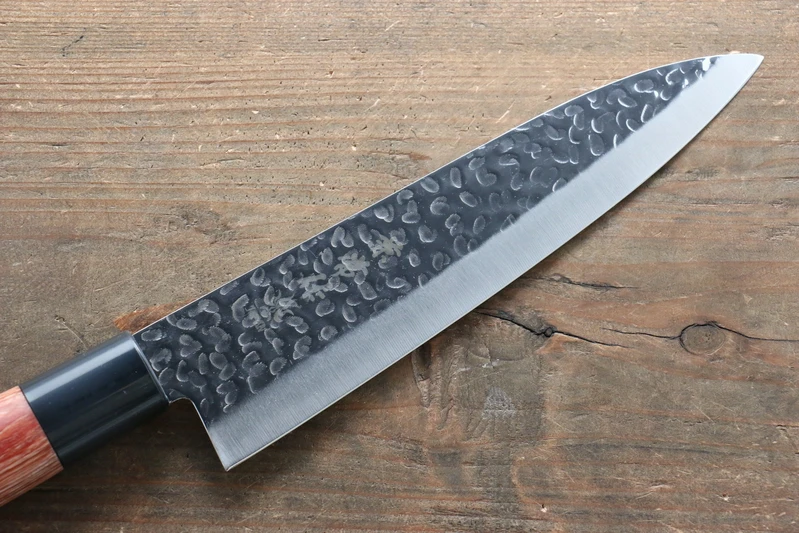
You don’t care about what metal your knife is made of? You just want an authentic Japanese Knife? Check out Chef Gokus top picks: The Best Japanese Knives – A Buying Guide
Steel type is one of the main factors people consider when buying a knife.
Unfortunately for us beginners, all of the Japanese knife steel options can be incredibly confusing.
Should I get stainless steel? Or high carbon steel? What the hell is Damascus steel? White steel? Blue steel? SUPER blue steel???
In this article, I try to make sense of it all, and help you choose the best Japanese knife steel type for yourself. We will learn:
- Basic properties of knife steel
- Elements of steel and their effect
- Stainless steel vs high-carbon steel
- List of common Japanese knife steel types
Just remember that a blade made with a high-end steel does not necessarily mean a high quality knife. You must also take into consideration all steps of the knife manufacturing process (forging, heat treatment, etc.), skill of the knife maker, as well as other things like the blade shape, handle, and so on.
Lets get started:
Japanese Knife Steel Basics
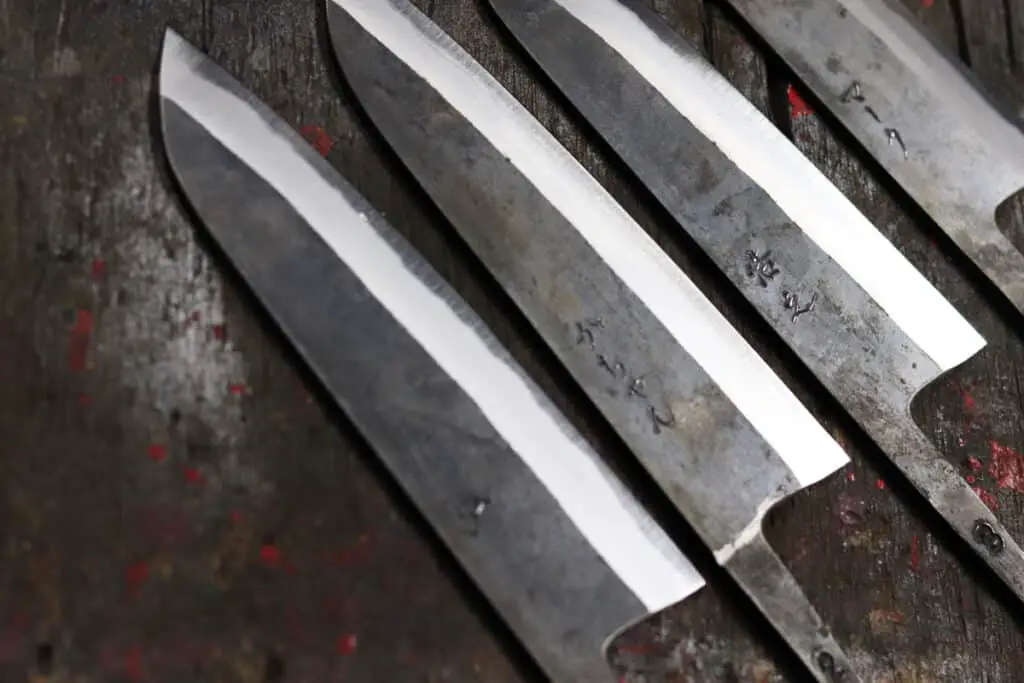
First, we need to understand some of the basic science and terminology of steel. Then, we can better understand the difference between all the Japanese knife steel types out there. There is actually a whole field of study dedicated to this (i.e.
Properties of knife steel
What is the difference between hardness, toughness, strength, etc? In everyday life, you may think that if something is tough, it is also strong or hard. When referring to steel, there is a difference. This was probably the most confusing thing for me understand when first reading about different steel types. Below is some common terminology for blade steel properties.
Hardness
Hardness refers to a material’s ability to resist deformation, indentations, or scratches. Think about diamonds — the hardest natural mineral on earth. You can’t easily scratch, bend or deform a diamond (unless maybe you use another diamond).
The hardness of knife steel is commonly rated using the Rockwell C scale (i.e. HRC). For kitchen knives, anything with 60+ HRC is considered to be on the harder side. Something around 55 HRC would be considered soft. A knife blade that has high hardness will be able to keep its sharp edge for a longer time, but will also be more difficult to sharpen when the time comes.
Hardness is directly correlated with strength, but not with toughness.
Strength
Strength is the amount of force needed to deform the steel. The higher force needed, the stronger the steel is. It is directly related to hardness — the harder a steel is, the stronger it is.
In regards to knives, a strong blade is usually desired so that the edge is not easily deformed when cutting. Knives made with very soft steel require frequent honing to keep the edge straight. Most Japanese knives will use hard/strong enough steel that does not require frequent honing.
Toughness
Toughness refers to the steel’s ability to resist fracturing / chipping / cracking when hit with force. In general, toughness is inversely related with hardness. This means that the harder a blade is, the less tough it is (i.e. the easier it is to chip / crack).
Therefore, knife makers always need to make a trade off between hardness and toughness. Japanese knives tend to favor hardness, so must be
Wear Resistance
Wear resistance refers to the steel’s ability to withstand damage from abrasion (i.e. scrapes / scratches). If a harder object scrapes across a softer object, the softer object will incur abrasive wear. Therefore, wear resistance is directly correlated with hardness. It also has to do with the carbide size of the particular steel. Carbide is the chemical compound of carbon and other metallic elements ( i.e. chemistry stuff I don’t really understand..). Basically, steels with larger carbides are more wear resistant (assuming equal hardness).
Corrosion Resistance
Corrosion resistance is the ability for the steel to not corrode (i.e. rust or stain) due to external factors such as moisture, humidity, salt, etc. Acidic foods like lemons can also cause corrosion, and affect the knife’s performance. Corrosion resistance is generally inversely related with wear resistance.
Edge Retention
Edge retention refers to a blade steel’s ability to remain sharp after use. It is sort of a combination of all the above properties, and also dependent on the knife’s purpose (i.e. what is it being used to cut). For example, if you are constantly cutting lemons, then a knife with high corrosion resistance would also increase edge retention. For most basic food prep (vegetables, fish, meats), a knife with high hardness (i.e. HRC) would have better edge retention. If you are cutting bone and other hard materials, then a knife with high toughness would have better edge retention.
Ability to take an edge
This refers to how sharp of an edge a steel can take relative to other steels if sharpened the exact same way. In general, finer-grained steels can get a sharper edge more easily than coarse-grained steels. Steel grain size depends on elements included in the steel (vanadium helps decrease grain size), as well as the forging process.
Purity
Purity refers to the level of unwanted elements such as Phosphorus and Sulphur. Cleaner, purer steels perform better than dirtier, impure steels. A purer steel will typically be stronger and tougher.
Elements of Japanese Knife Steel
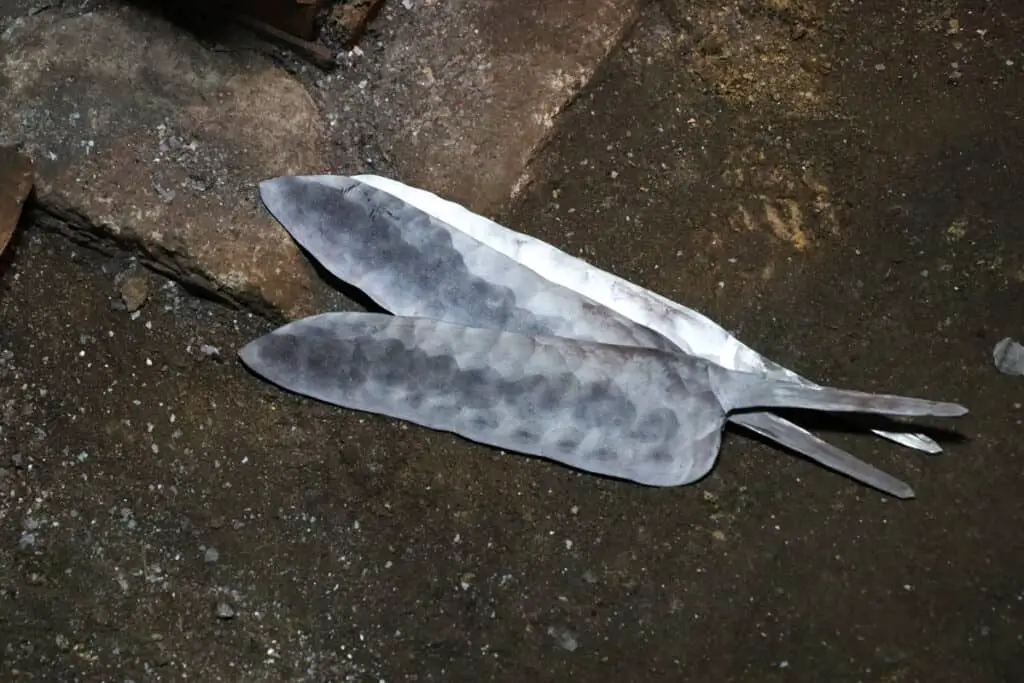
Now that we understand some basic properties of steel, we can look at the elements that are used to achieve these properties. Time to dust off that old chemistry textbook!
At its simplest, steel is a metal alloy made of elements iron and carbon. Pure iron is soft, so adding carbon helps increase its strength. Too much carbon though will make the alloy brittle and not practical for daily use. Typically, the carbon content of steel ranges anywhere from 0.002% to 2.14% (of its total weight). For Japanese knife steel, it is usually somewhere around 1%.
Besides iron and carbon, many other elements can be added to the alloy, which will change its properties and performance. Steel producers are always in search of the optimal combination of elements which will result in the best performing steel for its specified purpose (in our case — kitchen knives). Below is a list and short description of each elements you may find in Japanese knife steel.
Carbon (C)
By definition, carbon is found in all steels. Its role is to harden the steel and increase overall strength. It also makes the steel more brittle (i.e. decreases toughness). Knife-grade steel should have over 0.5% carbon.
Chromium (Cr)
The main role of chromium is to improve corrosion resistance / rust resistance. “Stainless steel” is defined as steel that has a minimum of 11% chromium. This percentage varies a bit according to different sources — usually between 10-14%. Chromium also helps increase hardness, but decreases toughness.
Cobalt (Co)
Cobalt increases hardness, and allows for higher quenching temperatures (during the heat treatment procedure). This intensifies the individual effects of other elements in more complex steels.
Manganese (Mn)
Manganese is used to increase the ‘hardenability’ of steel — i.e. the ability to achieve higher hardness ratings. It also helps improve corrosion resistance, and is often found in stainless steels.
Molybdenum (Mo)
Molybdenum improves toughness (i.e. prevent brittleness), and helps steel maintain strength at high temperatures. It also increases resistance to corrosion, so is frequently found in corrosion-resistant or stainless steels.
Nickel (Ni)
Nickel is another element that is corrosion resistant and often found in stainless steel. It also adds strength and toughness.
Phosphorus (P)
Phosphorus is found in small amounts in nearly all steels; it is considered an impurity, and a contaminant which reduces toughness.
High end steels like Super Blue will have fewer impurities, and thus less Phosphorus.
Sulphur (S)
Similar to Phosphorus (P), Sulphur is also an impurity, and always found in steel in small quantities. Sulphur increases brittleness if the amount is too high and manganese is too low. Sulphur does help to improve machinability of steel, so depending on purpose of the steel, it is sometimes added in combination with increased manganese.
Silicon (Si)
Silicon helps improve hardness and strength of steel. It acts as a deoxidizer in the making of steel (i.e. remove excess oxygen so there are no bubbles in the steel.)
Tungsten (W)
Tungsten improves wear resistance. It also helps make steel stronger and harder.
Vanadium (V)
Vanadium is one of the most important elements used to increase hardness and hardenability of knife steel. It also contributes to improve wear resistance and toughness.
Stainless steel vs High-Carbon steel vs Other
Japanese knife steel is generally categorized into two groups — stainless steel and high carbon (non-stainless). Let’s see what the basic differences are, and also take a look at a couple of other options you may come across.
Stainless Steel Knives
Steel that has a high chromium (Cr) content of at least 11% is considered stainless steel. The exact minimum percentage can vary a bit depending on who you’re talking to, but usually ranges from around 10% to 14%. Other elements are also added to further enhance corrosion resistance and other knife properties.
The main benefit of stainless steel is that it does not rust easily (i.e. high corrosion resistance), and is therefore easier to maintain. Despite the name, stainless steel will still rust over time if not taken care of properly. The main drawback of stainless steel knives is that they have a lower hardness levels compared to high carbon knives. The HRC typically ranges from around 56-61 for most Japanese stainless steel knives.
Overall, Japanese stainless steel knives are cheaper than high-carbon steel knives. This combined with easier maintenance make stainless steel knives the popular and practical choice for most people.
High carbon steel knives (non-stainless)
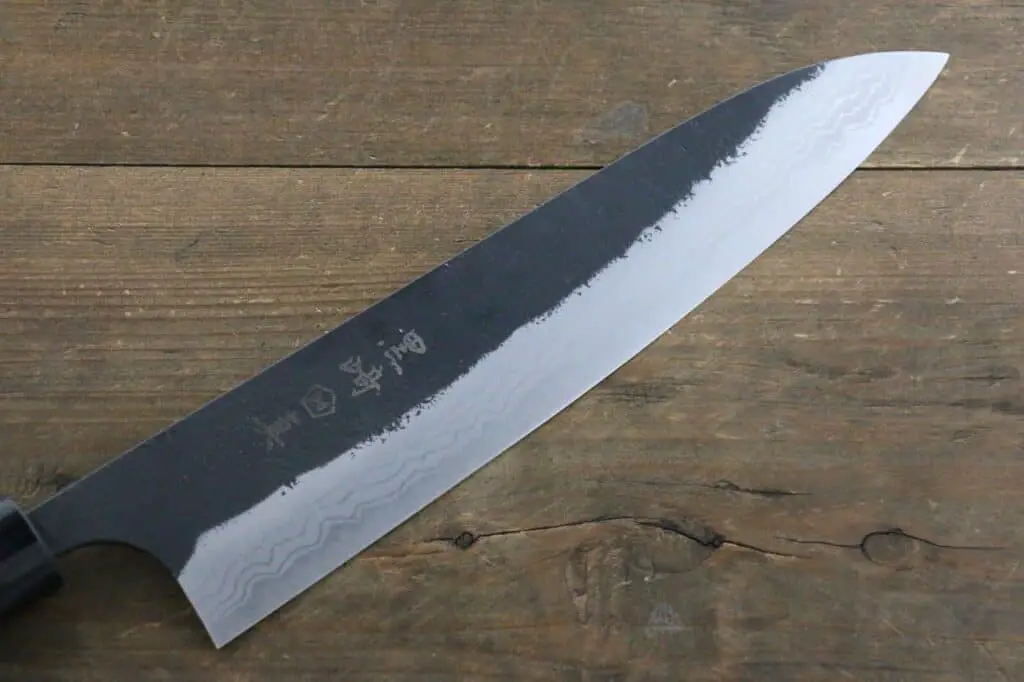
If you see the term ‘carbon steel’ knives, it is probably actually referring to ‘high carbon, non-stainless steel’ knives . Since all steel has carbon, the simple term ‘carbon steel’ does not really make sense. Also, since there are ‘high-carbon stainless steel’ knives, the most appropriate term would actually be something like ‘high-carbon (non-stainless) steel’ knives. Unfortunately, that is a bit long, so we will just refer to it as ‘high-carbon steel’ from here on…
General high-carbon steel is loosely defined as steel with a minimum 0.5% carbon content. Again, this percentage varies, but is usually between a minimum of 0.5% to 0.8%. Most Japanese high-carbon steel knives will have a carbon content of greater than 1%.
The main benefit of high-carbon knives is that they typically have a higher hardness level (HRC 60 to 65+). This allows the blade to retain a sharp edge for a long time. The downside is that they are more brittle (i.e. lower toughness), and will rust/stain easily if not taken care of.
Other: Powdered Steels (i.e. P.M Steel)
Powdered Metallurgy steels (i.e. PM steel or powdered steel for short) is a relatively new category in kitchen knives. Powdered metallurgy refers to the way the steel is made rather than the actual type of steel it is. This means that PM steels can be either stainless or non-stainless (although most are stainless steels). The process used for PM steels allows steel makers to develop unique high performance metal alloys that would otherwise not be possible with more traditional methods. If you want to learn more, check out this post at
The main benefit for kitchen knives made with PM steel is that they can achieve extremely high hardness levels without sacrificing too much toughness. Many PM steel knives have a hardness rating of HRC 64-68. The main downside of PM steel knives is that they are much more expensive due to the more intricate manufacturing process. Therefore, PM steels are usually recommended for extreme knife enthusiasts or professionals.
What the hell are Damascus steel kitchen knives?
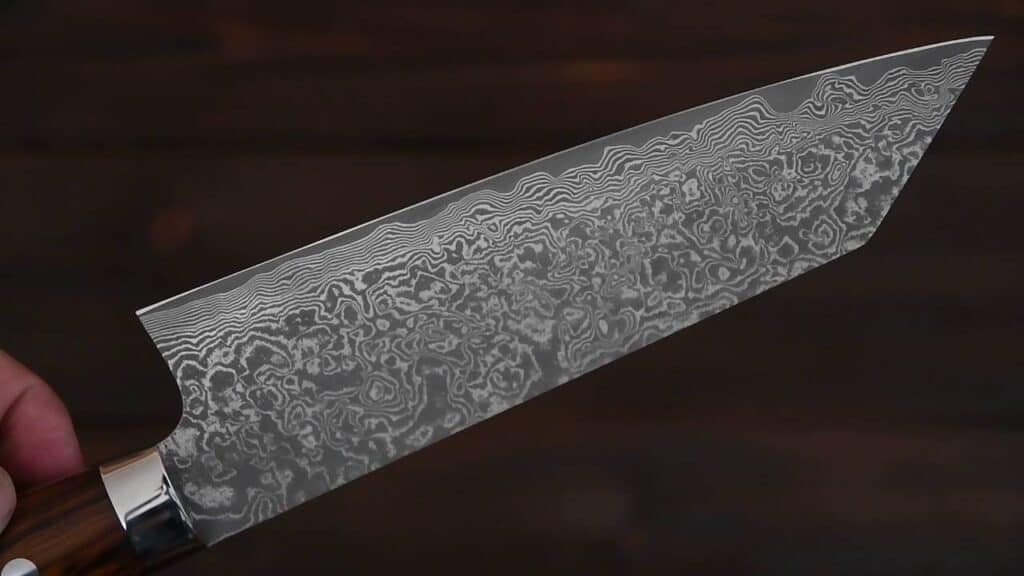
You may have come across ‘Damascus steel’ knives. They have cool, swirly/wavy patterns on the face of the blade. The term Damascus steel is just a way to refer to knives with this patterned style. It is no indication of the actual performance or quality of the steel itself. ‘Dasmascus’ is actually the name of a city in the Middle East (Syria), which I assume patterns like these originated from. The wavy patterns are achieved by folding multiple different steels together in the forging process. Damascus steel knives can be either stainless steel or high-carbon steel.
List of Japanese knife steel types
Finally, let’s take a look at some common Japanese knife steel types. These are what you will usually find in knife product descriptions. Japanese knife makers source steel from various steel manufacturers in Japan, as well as some other parts of the world. Some bigger knife brands have their own proprietary steel names/blends, and do not disclose the exact composition.
I will break the Japanese knife steel types into two main groups: Stainless Steels and High-Carbon Steels. Powdered (PM) steels will be placed in either group appropriately. Most PM steels are proprietary, and companies don’t reveal their exact composition.
Note: PM Steels are marked with an *
Japanese Stainless Steel Types
Cowry-X*
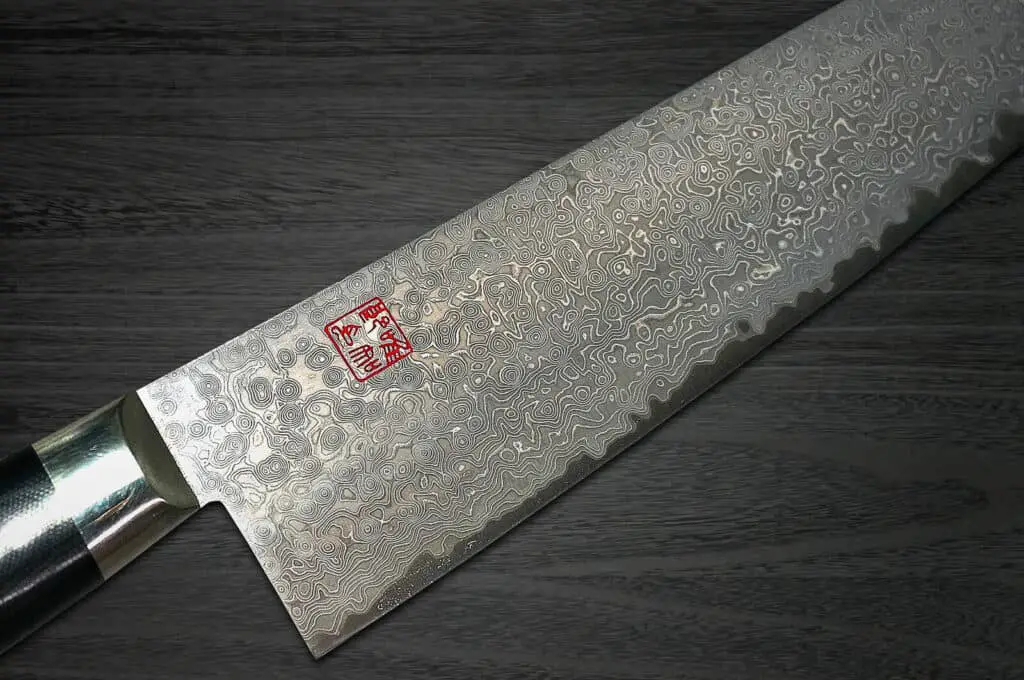
Cowry-X is a so-called “super” PM steel made by
Unfortunately, it is crazy expensive, and also extremely difficult to work with for knife makers. Forget about regular bums like me trying to sharpen it. The only Japanese knife maker known to use Cowry-X is the legendary Hattori Ichiro. This steel is probably only for collectors.
Example knife available at Hocho Knife: Hattori KD30 COWRY-X 121 Layered Damascus Gyuto Knife 210mm
Elemental composition of Cowry-X: (Source)
| Element | C | Cr | Mo | V | Hardness |
|---|---|---|---|---|---|
| % | 3.00 | 20.00 | 1.00 | 0.30 | HRC 63≦ |
ZDP189 / MC66*
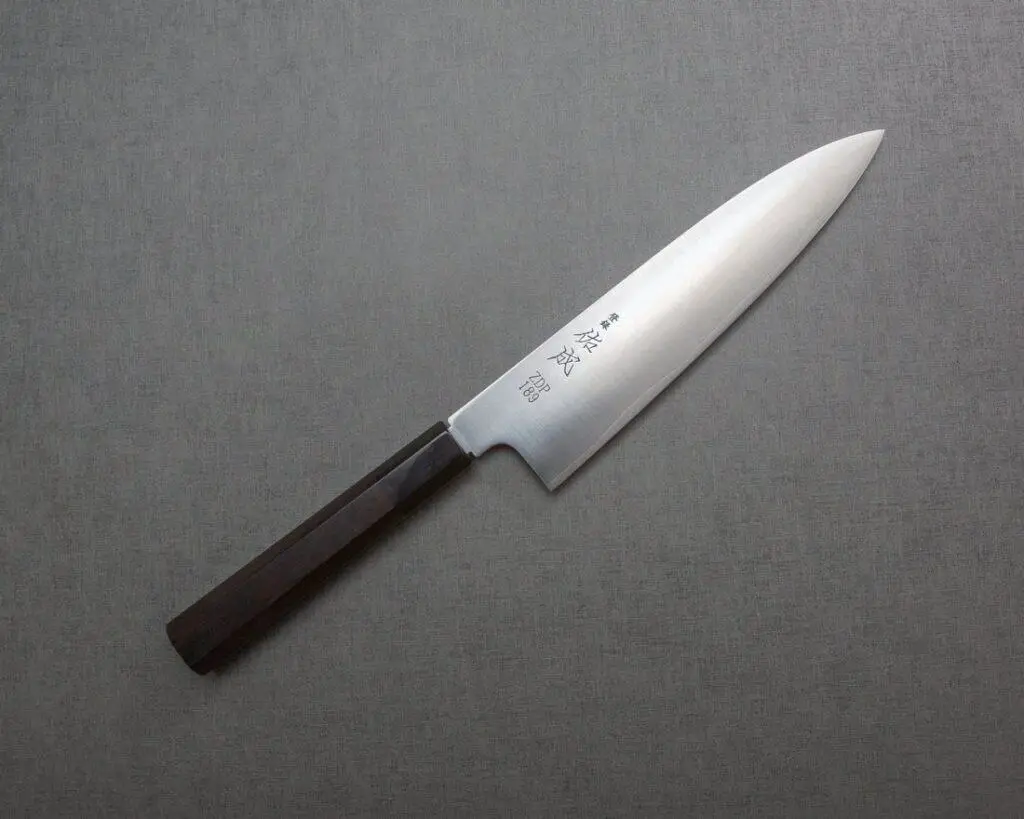
This is another “super” PM steel developed by
ZDP189 is the hardest steel made by Hitachi, and can reach levels of HRC 67 and above. Its base hardness level is HRC 65. It is comparable to Super Blue (i.e. Super Aogami) steel. This means that the steel should have extremely good edge retention, but also will be difficult to sharpen.
ZDP189 is also stated to have good toughness and corrosion resistance. There have been mixed reviews in regards to this with some users saying that the blade tends to chip easily and is not actually that corrosion resistant relative to other stainless steels. The guy over at Knife Steel Nerds did not have a good impression of ZDP189 (read his review here).
It probably depends a lot on the knife maker, as it seems to be a difficult steel to work with. I do not have any first hand experience with ZDP189 knives, so you’re going to have to try and let me know. ZDP-189 knives are quite expensive.
Affordable example of a ZDP189 steel knife available on Amazon: Xinzuo ZDP-189 Gyuto 8 Inches
Elemental composition of ZDP189 (Source: zknives)
| Element | C | Cr | Mo | V | W | Mn | Si | Hardness |
|---|---|---|---|---|---|---|---|---|
| % | 3.00 | 20.00 | 1.40 | 0.10 | 0.60 | 0.50 | 0.40 | HRC 65≦ |
SG-2 (Super Gold No. 2) / SPG-2 / R-2 *
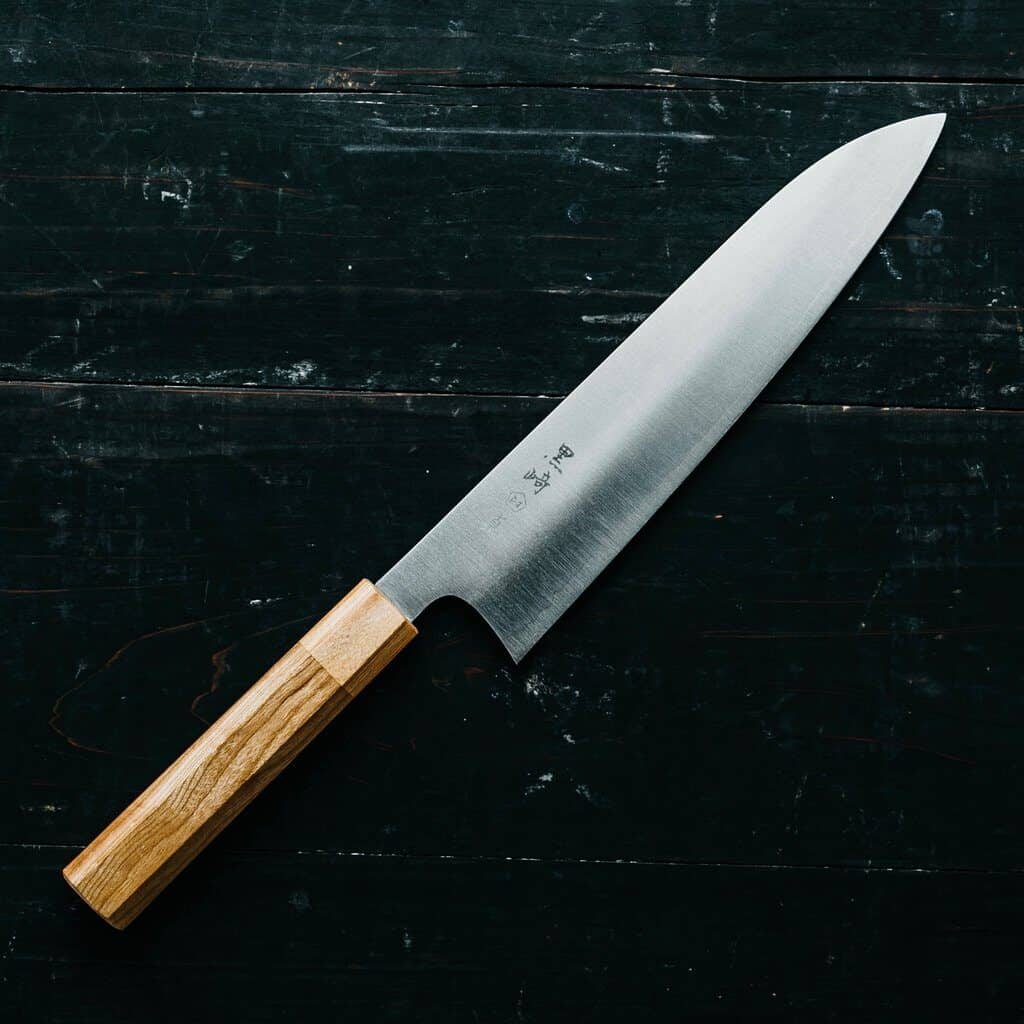
SG-2 / SPG-2 (i.e. Super Gold No. 2) steel from Takefu Steel is the most common and affordable Powdered Metturalgy (PM) steel used for Japanese knives. Sometimes, you will see the steel listed as R-2 Steel. R-2 and SG-2 are actually the same steel. R-2 is manufactured by
SG-2 / R-2 can be hardened up to HRC 64, and has good corrosion/rust resistance. It has slightly lower edge retention compared to the higher end PM stainless steels (i.e. Cowry-X, ZDP189), but is tougher and easier to sharpen/maintain. Its combination of high cutting performance and manageable maintenance has made it a very popular choice for Japanese knife makers in recent years. Unlike Cowry-X/ZDP189, it is easy to find knives made with SG-2. The popular Japanese knife brand Shun uses SG-2 in some of its higher end lines.
Overall, SG-2 is an excellent mid to premium level Japanese knife steel type. It provides outstanding cutting performance and edge retention while still offering good corrosion resistant. It can be considered as a more premium version of the VG-10 stainless steel (also made by Takefu). Compared to entry-level stainless steels, beginners may find SG-2 knives more difficult to sharpen. They are also more expensive, with prices for a good SG-2 gyuto generally starting from around $200.
Example knife: Enso SG2 Chef’s Knife
Elemental composition of SG-2 / R-2 steel (Source):
| Element | C | Cr | Mo | V | Mn | Si | P | S | Hardness |
|---|---|---|---|---|---|---|---|---|---|
| % | 1.25 – 1.45 | 14.00 – 16.00 | 2.30 – 3.30 | 1.80 – 2.20 | 0.40 | 0.50 | 0.03 | 0.03 | HRC 61-64 |
VG-10
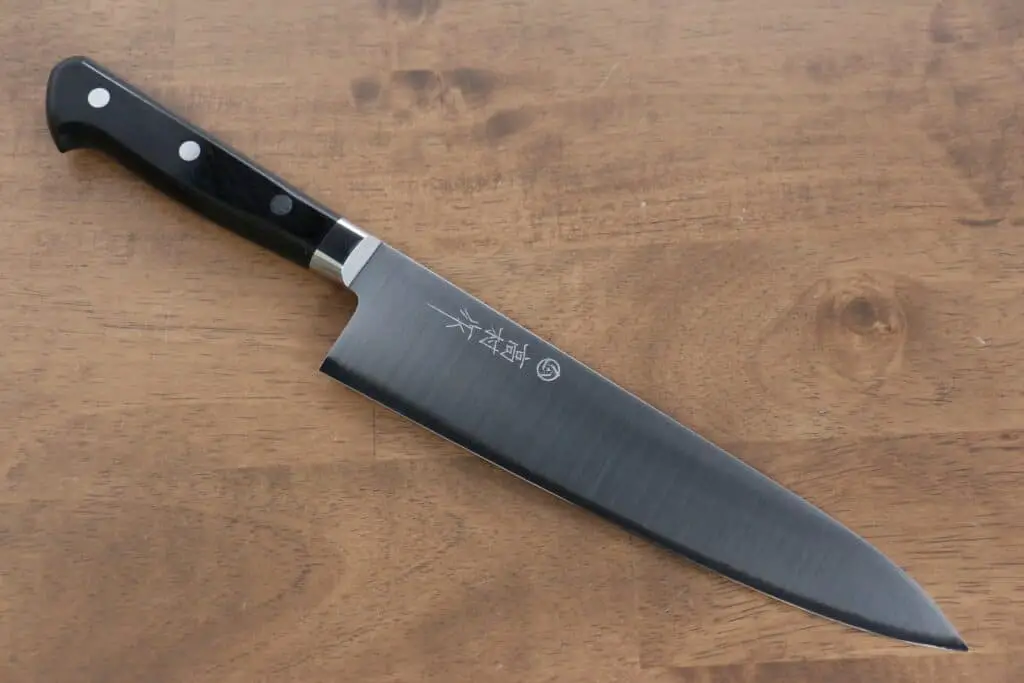
VG-10 (i.e. V Gold 10) is made by
Overall, VG-10 is a high quality Japanese knife steel type that is suitable for most beginner to intermediate users. VG-10 knives can be found in quite wide range of prices. Some are very affordable, including the recommended entry-level Tojiro DP line (see best kitchen knives for beginners).
Example knives:
Yoshihiro VG10 46 Layers Hammered Damascus Gyuto
Tojiro DP VG10 Gyuto 210mm
Elemental composition of VG-10 steel: (Source)
| Element | C | Cr | Mo | V | Co | Hardness |
|---|---|---|---|---|---|---|
| % | 0.95-1.05 | 14.50-15.50 | 0.80-1.20 | 0.15-0.35 | 1.30-1.80 | HRC 60≦ |
VG-1
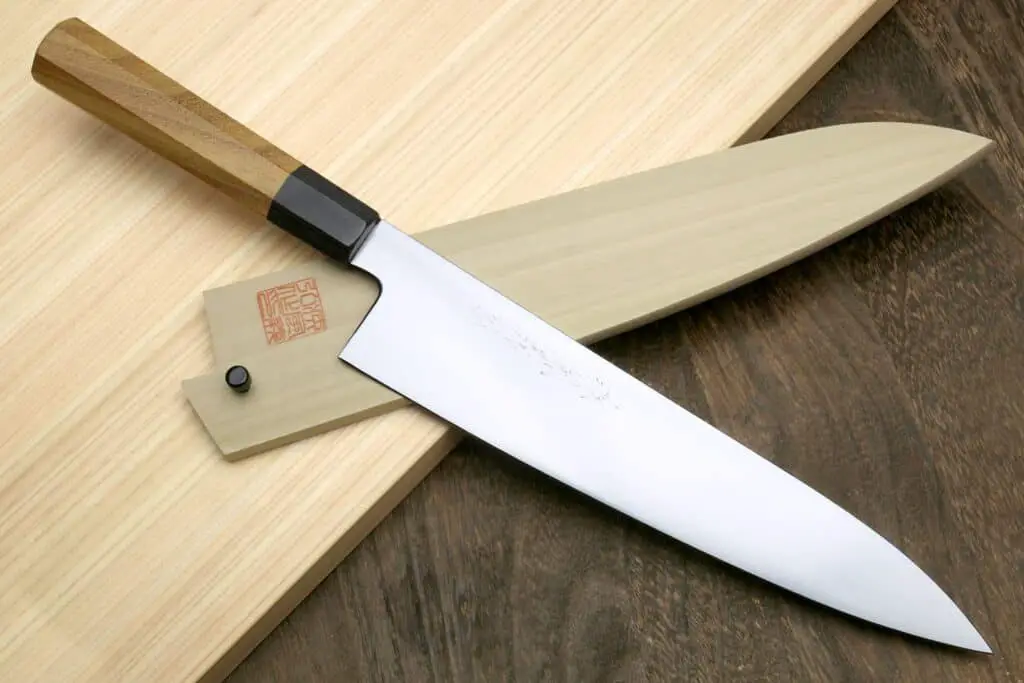
VG-1 is another steel made by Takefu Steel. It is sort of an older version of the above mentioned VG-10. The main difference is the lack of Vanadium and smaller amount of Molybdenum which makes it slightly less wear resistant. Otherwise, VG-1 performs very similarly to VG-10.
Overall, VG-1 steel has good corrosion resistance, edge retention and edge sharpness. It is capable of achieving a relatively high Rockwell hardness (60-61 HRC), and is an excellent choice for entry level Japanese knives. The beginner recommended Yoshihiro VG-1 Santoku uses this steel.
Example knife: Yoshihiro VG1 Gold Gyuto 270mm
Composition of VG-1 Steel (Source)
| Element | C | Cr | Mo | Ni | Hardness |
|---|---|---|---|---|---|
| % | 0.95-1.05 | 13.0-15.0 | 0.2-0.4 | ≦ 0.25 | HRC 60≦ |
Silver 3 / Ginsan-ko / Gingami #3 / Gin-3
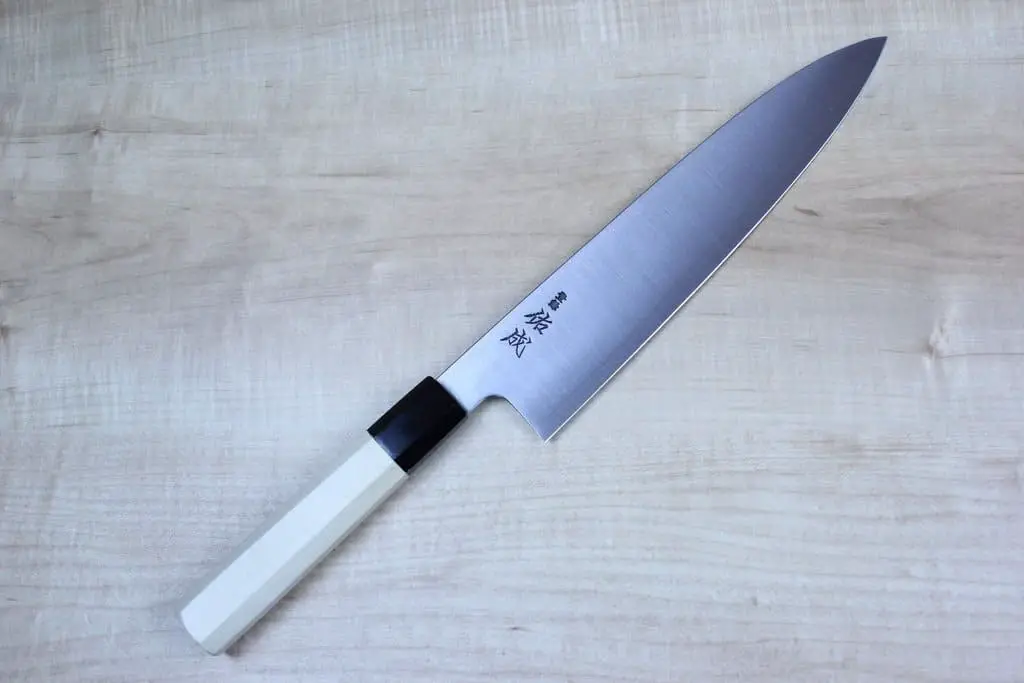
This popular steel made by
Silver-3 is an excellent stainless steel when in the hands of a skilled knifesmith, and is used in many mid to high end Japanese stainless steel knives. The aim of this steel is to simulate the benefits of high-carbon steel performance (sharpness, hardness), but with the corrosion resistance of stainless steel. It has approximately the same cutting performance of shirogami high-carbon steel (i.e. white steel), but with better corrosion resistance. Compared with the popular VG-10 stainless steel, it has worse corrosion resistance, but has better strength, and is easier to sharpen. Silver-3 knives can be found in a fairly wide range or hardness HRC 59-64.
Thanks to its excellent cutting performance, Silver-3 is also one of the few stainless steels used to make traditional Japanese style knives (i.e single-bevel blades).
Overall, Silver-3 is an excellent Japanese knife steel type. If you are looking for an intermediate to higher end stainless steel knife, then you should definitely consider it. Silver-3 is not generally recommended for absolute beginners because of more difficult maintenance (lower corrosion resistance).
Example knife: Sakai Takayuki Cingami No.3 Steel Deba Knife 225mm
Composition of Silver-3 (Source)
| Element | C | Cr | Mn | P | S | HRC |
|---|---|---|---|---|---|---|
| % | 0.95-1.10 | 13.0-14.5 | 0.60-1.00 | 0.03 | .020 | HRC > 59 |
Swedish Steel – AEB-H / 19c27
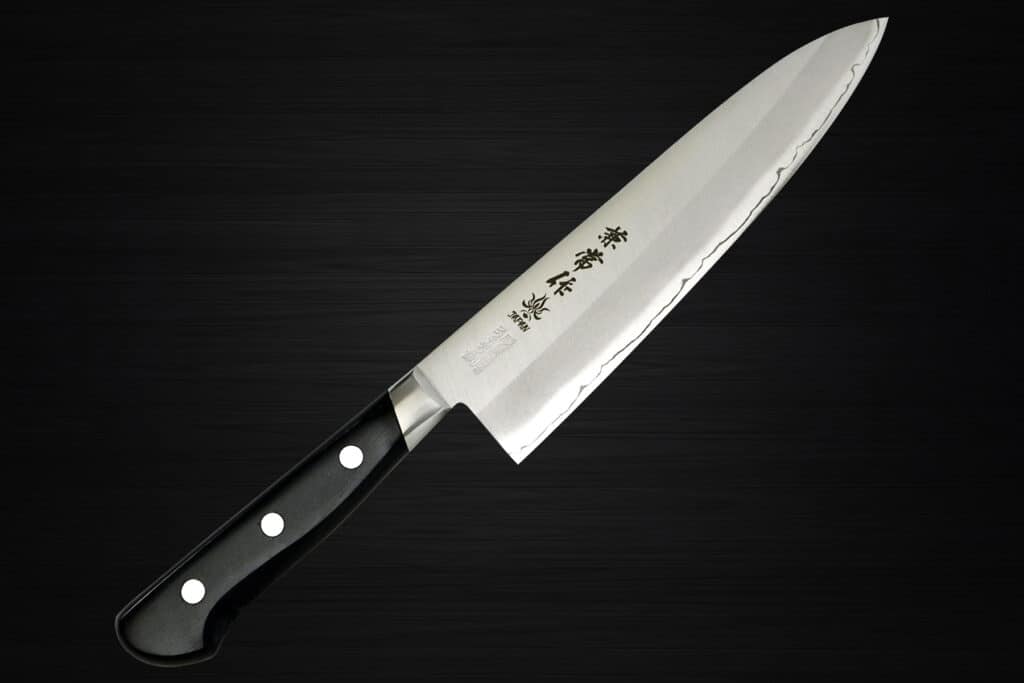
When you see the term “Swedish Stainless Steel” in Japanese knives, it is most often referring to 19c27 steel made by
AEB-H / 19c27 steel can achieve excellent hardness, along with very high wear and corrosion resistance. The steel is listed by Sandvik as having a possible HRC range of 55-63. Japanese knife makers will tend to harden the steel to at least HRC 60+.
Overall, 19c27 is an excellent steel that can achieve a good balance between hardness/toughness, and is not difficult to sharpen when necessary.
Example knife (19c27): Kanetsune KC-150 Swedish Stainless Steel Gyuto 185mm
Composition of 19c27 Swedish Steel (Source)
| Element | C | Cr | Mn | Si | P | S | HRC |
|---|---|---|---|---|---|---|---|
| % | 0.95 | 13.5 | 0.7 | 0.40 | <= 0.025 | <= .01 | HRC 55 – 63 |
Swedish Steel – AEB-L / 13c26
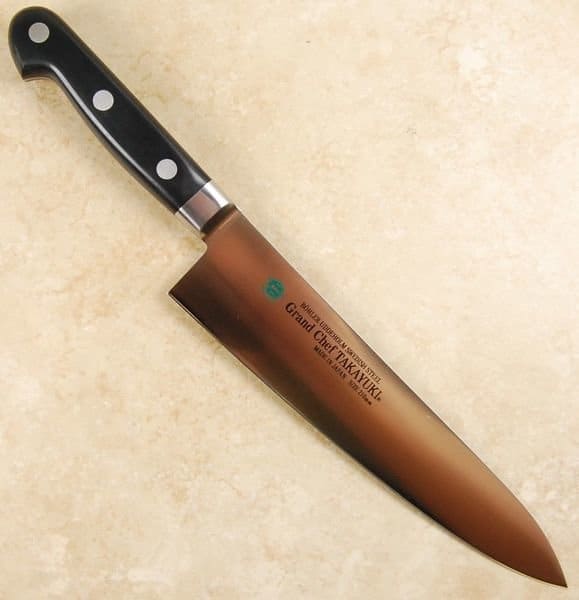
Another Swedish stainless steel that is commonly used in Japanese knives is AEB-L / 13c26. Sandvik makes 13c26, while Uddeholms’ version is called AEB-L. They are almost exactly the same, except AEB-L has 0.01% less carbon and 0.1% more Manganese.
The AEB-L / 13C26 steel is similar to the above AEB-H / 19c27, but it has less amounts of Carbon and Chromium in its composition. It can be hardened to similar levels, and is mainly used at around 60 HRC for Japanese kitchen knives. One major difference is that AEB-L/13c26 has smaller carbides, which make it easier to sharpen and allows it to take a finer/sharper edge.
The steel was originally developed in 1960s for razor blades, and has also become the standard grade for surgical knives. It has recently become very popular with kitchen knife makers worldwide due to its excellent properties. Mainly, it is able to hold a very hard, fine edge (‘razor’ thin some may say), while still retaining excellent toughness to avoid chipping. A lot of thin ‘mono-steel’ style blades are made with AEB-L / 13c26.
Overall, AEB-L / 13c26 is an excellent stainless steel choice for entry to mid-level knives. Knives made with this steel are also usually relatively affordable, and easy to maintain/sharpen.
Example knife: Takayuki Grand Chef AEB-L Gyuto 210mm
Composition of 13c26 Swedish Steel (Source)
| Element | C | Cr | Mn | Si | P | S | Hardness |
|---|---|---|---|---|---|---|---|
| % | 0.68 | 13.0 | 0.7 | 0.40 | <= 0.025 | <= .01 | HRC 55 – 62 |
ACUTO440
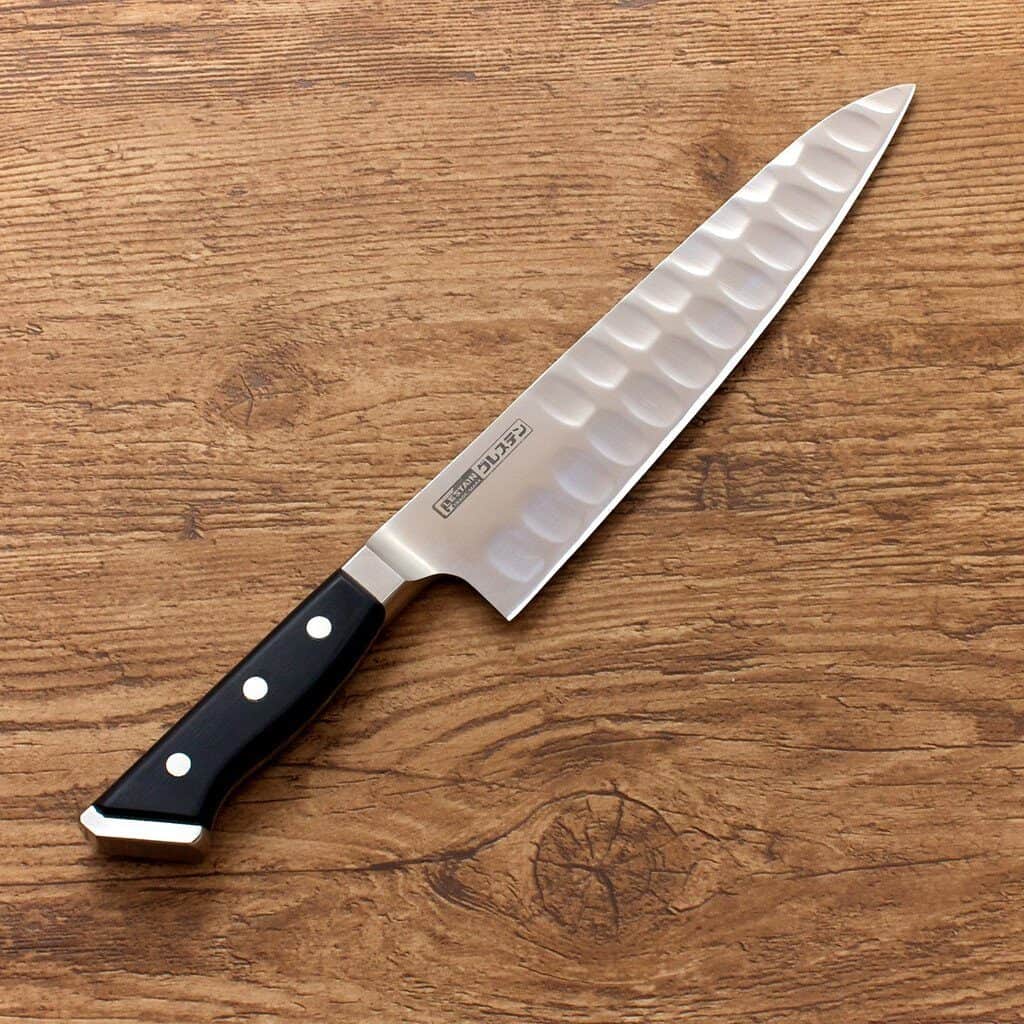
ACUTO440 was developed by
The steel was created as a better cutting version of the standard JIS SUS440C (i.e. AISI 440C) steel. It has very good corrosion resistance thanks to its high level of Chromium, is durable, and is able to hold a sharp cutting edge thanks to the addition of Molybdenum and Vanadium. Typically, Glestain knives have a hardness of HRC 58-59.
Example knife: Glestain K Series Gyutou 210mm
Composition of ACUTO440 (Source)
| Element | C | Cr | Mn | Si | P | S | Mo | V | Hardness |
|---|---|---|---|---|---|---|---|---|---|
| % | 0.80 – 0.95 | 17.0-18.0 | 0.25-0.40 | 0.35-0.50 | ≦0.04 | ≦0.03 | 1.00-1.25 | 0.08-0.12 | HRC 58-59 |
AUS-8 / AUS-10
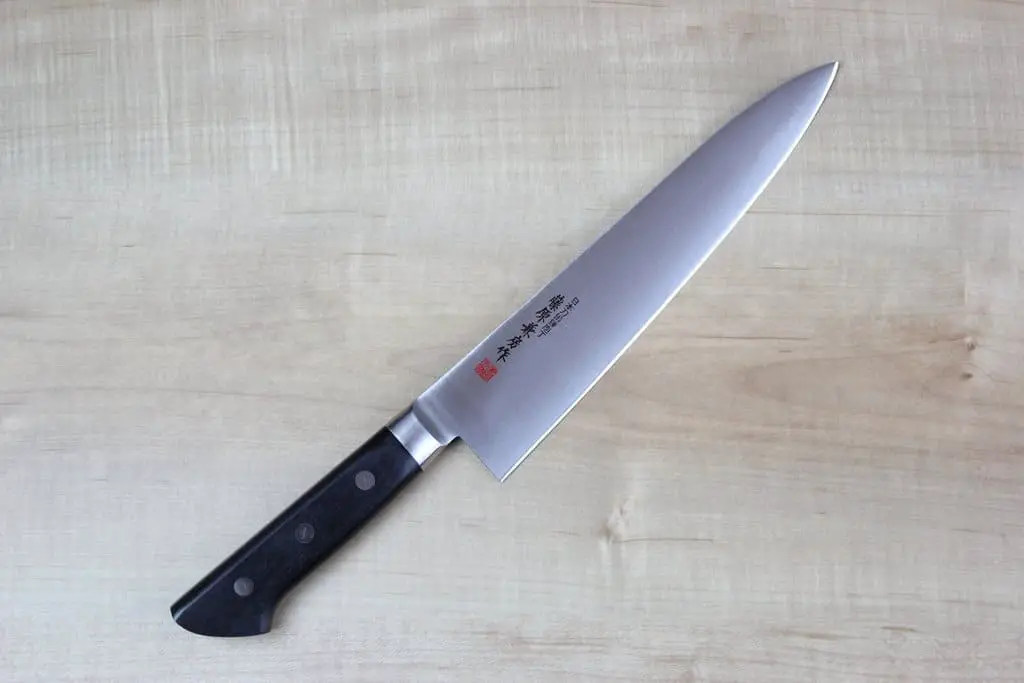
AUS-8 and AUS-10 are also developed by Aichi Steel. They have significantly less Chromium than the above mentioned ACUTO440, and are considered as more entry-level stainless steels for Japanese knives. AUS-10 is the more ‘premium’ of the two as it has better cutting performance and edge retention than AUS-8 thanks to its higher Carbon content.
Overall, both of these Japanese knife steel types exhibit solid overall properties — wear resistance, toughness, and able to take a decent edge. They are easy to sharpen, and budget friendly which makes them an excellent entry-level choice for first time users of Japanese knives. The
Aichi also makes a lower version called AUS-6, although it is usually not used in Japanese kitchen knives.
Example AUS-8 knife: Fujiwara Kanefusa FKM Series Gyuto 210mm
Example AUS-10 knife: Yoshihiro Inox Stain-resistant Aus-10 Gyuto 210mm
Composition of AUS-8 (Source)
| Element | C | Cr | Mn | Si | P | S | Mo | V | Hardness |
|---|---|---|---|---|---|---|---|---|---|
| % | 0.70-0.80 | 13.0-14.5 | ≦0.50 | ≦0.8 | ≦0.04 | ≦0.005 | 0.10-0.30 | 0.10-0.25 | HRC 59 |
Composition of AUS-10 (Source)
| Element | C | Cr | Mn | Si | P | S | Mo | V | Hardness |
|---|---|---|---|---|---|---|---|---|---|
| % | 0.95 – 1.10 | 13.0-14.5 | ≦1.0 | ≦0.8 | ≦0.04 | ≦0.005 | 0.10-0.30 | 0.10-0.25 | HRC 60 |
Molybdenum Steel / Molybdenum Vanadium Steel / MV Steel
This is a generic name for knife steels that contain both Molybdenum and Vanadium. For example, AUS-8 can be called a Molybdenum Vanadium Steel, but is typically labelled AUS-8 for branding purposes. Some knife brands that use their own proprietary steel composition or do not want to use a steel company’s brand, will instead use the generic name “Molybdenum Vanadium steel”, or just “Molybdenum steel” for short.
A knife steel with both Molybdenum and Vanadium (compared to an identical steel without) means it will have increased hardness/strength, as well as improved toughness and wear resistance. Molybdenum also helps to increase a steel’s corrosion resistance.
Usually, knives that are labelled as Molybdenum Steel (or MV Steel) are on the more budget friendly side (i.e. AUS-8 to AUS-10 price range). Some popular Japanese knife brands that use a proprietary MV steel include Global Knives (i.e. Chromova18 steel), Misono’s Molybdenum and 440 lines, Masamoto (“Hyper Molybdenum Vanadium”), MAC Knives, and Fujiwara FKM Stainless Series.
Many of the
Japanese Knife High-Carbon Steel types
Below is a list of commonly found high-carbon Japanese knife steel types. Higher end, traditional style (i.e. single-bevel) Japanese knives tend to use high-carbon steels.
HAP-40*
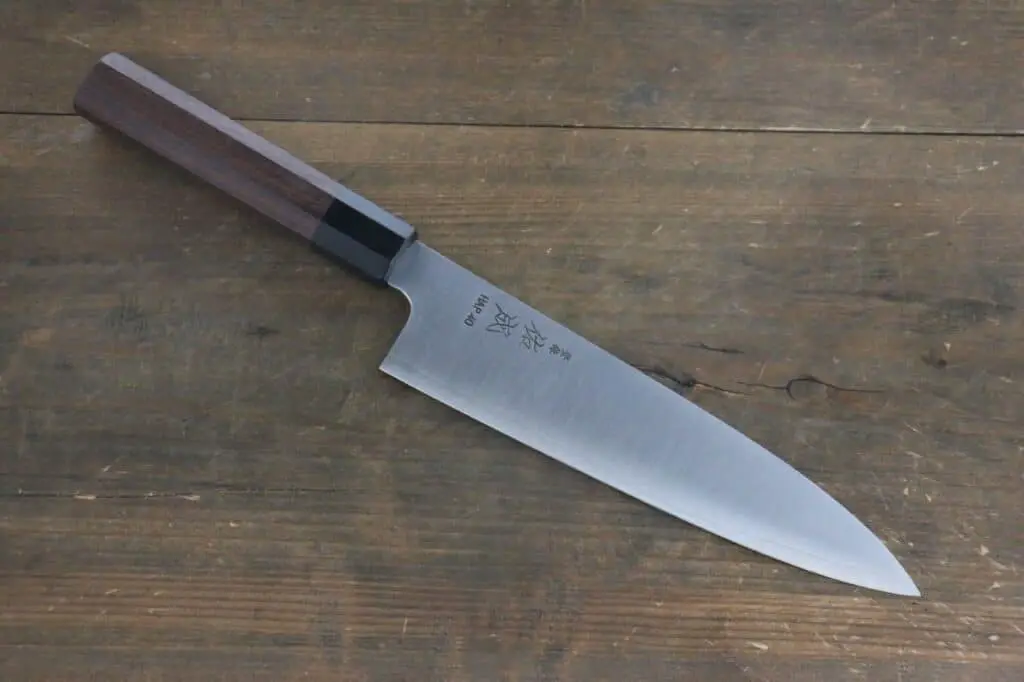
HAP-40 is a Powdered Metallurgy (PM) steel made by Hitachi Steel. When forged and treated properly, it is considered by many to be the best performing steel currently available in Japanese kitchen knives.
HAP-40 is actually considered a “semi-stainless” steel. What the hell does that mean? Basically, the steel does not have enough chromium (CR) or other corrosive resistant elements to be considered as real “stainless”, but it still offers better resistance than simple carbon steels.
HAP-40 can achieve extremely high hardness (HRC 68), which gives it incredible cutting performance and edge retention. It is on par with the previously mentioned ZDP-189 (stainless steel), and Super Blue high-carbon steel. What sets it apart, is that it also offers better toughness than both. This means it will be less prone to chipping.
The only real downside of such a great steel is its higher price. But, if you are an enthusiast looking for the latest and greatest blade steels (and have some extra money around), then you should definitely consider a knife made with HAP-40.
Example knife: Sukenari HAP40 3 Layer Gyuto 210mm
Composition of HAP-40 (Source)
| Element | C | Cr | Mn | W | V | Co | Hardness |
|---|---|---|---|---|---|---|---|
| % | 1.27-1.37 | 3.70-4.70 | 4.60-5.40 | 5.60-6.40 | 2.80-3.30 | 7.50-8.50 | HRC 64-68 |
Super Blue Steel / Super Blue Paper Steel (i.e. Super Aogami)
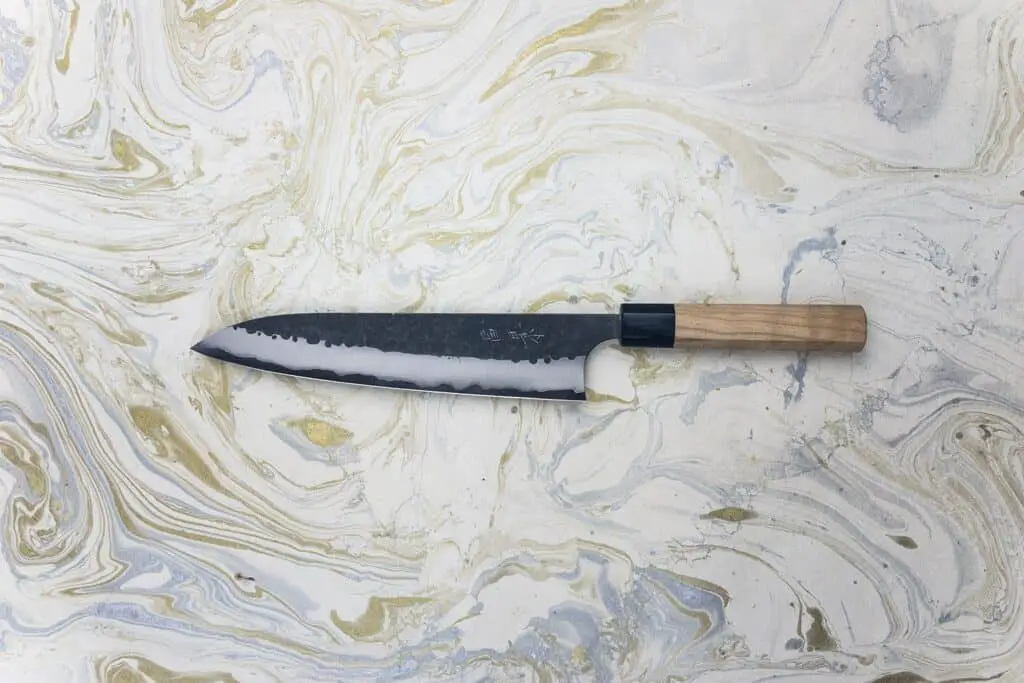
Super Blue Steel is the most premium high-carbon (non powdered) steel used in Japanese kitchen knives today. It is also made by Hitachi.
It has a very high carbon percentage (up to 1.50%), and is very pure, which allows it attain and retain a very sharp edge relative to other steels. Super blue steel knives can be found with hardness range of HRC 60 – 65. Most will be found in the 62+ range.
Blue Steels are most often used in high end traditional Japanese knives (i.e. single bevel blades). The steels can take a very thin, fine edge that stays sharp for a long time. This makes them suitable for more intricate, delicate cutting techniques often used for preparing traditional Japanese cuisine (i.e. washoku).
The main difference between “super” blue steel, and regular blue steel (see below), is that the super version has more carbon, while also adding vanadium and extra amounts of molybdenum, and chromium. These extra elements helps increase the steel’s overall toughness and wear resistance. This basically means that super blue can retain a sharper edge while also being less brittle.
If budget was not a constraint, many professionals and knife enthusiasts would choose super blue steel as the best Japanese knife steel type. Like any other high-carbon steel, the main downside is that it will easily stain or rust if not taken care of properly. Therefore, it is not recommended for entry-level users until they have some experience caring for knives.
Example knife: Masakage Koishi AS Gyuto 210mm
Composition of Super Blue Steel (Source)
| Element | C | Cr | Mn | W | V | Si | P | S | Hardness |
|---|---|---|---|---|---|---|---|---|---|
| % | 1.40-1.50 | 0.30-0.50 | 0.20-0.30 | 2.00-2.50 | 0.30-0.50 | 0.10-0.20 | ≦0.025 | ≦0.004 | HRC 60+ |
Blue Steel / Blue Paper Steel (i.e. Aogami) – #1, #2
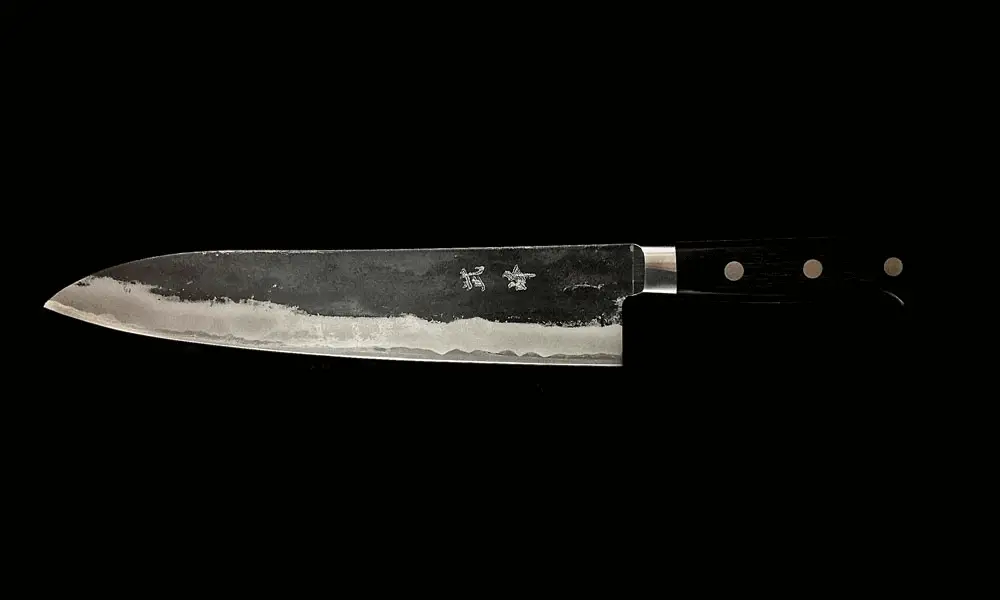
A slight step down from Super Blue Steel is plain ol’ Blue Steel. There are two grades – Blue Steel #1 and Blue Steel #2. The composition of each is almost the same, with the main difference being that Blue Steel #1 has higher amounts of Carbon (C). This gives #1 slightly better edge retention (hardness), but decrease in toughness. Compared to Super Blue Steel, the non-super versions do not contain any Vanadium.
Most quality blue steel knives will be on the more expensive side, and are not recommended for beginners as they require experience to maintain properly.
Example blue steel #1 knife: Nakagawa Hamono Aoichi Damascus Gyuto 240mm
Example blue steel #2 knife: Fujimoto Nashiji Gyuto 210mm
Composition of Blue Steel #1 (Source)
| Element | C | Cr | Mn | W | Si | P | S | Hardness |
|---|---|---|---|---|---|---|---|---|
| % | 1.25-1.35 | 0.30-0.50 | 0.20-0.30 | 1.50-2.00 | 0.10-0.20 | ≦0.025 | ≦0.004 | HRC 60+ |
Composition of Blue Steel #2 (Source)
| Element | C | Cr | Mn | W | Si | P | S | Hardness |
|---|---|---|---|---|---|---|---|---|
| % | 1.05-1.15 | 0.20-0.50 | 0.20-0.30 | 1.00-1.50 | 0.10-0.20 | ≦0.025 | ≦0.004 | HRC 60+ |
White Steel / White Paper Steel (i.e. Shirogami) – #1 , #2, #3
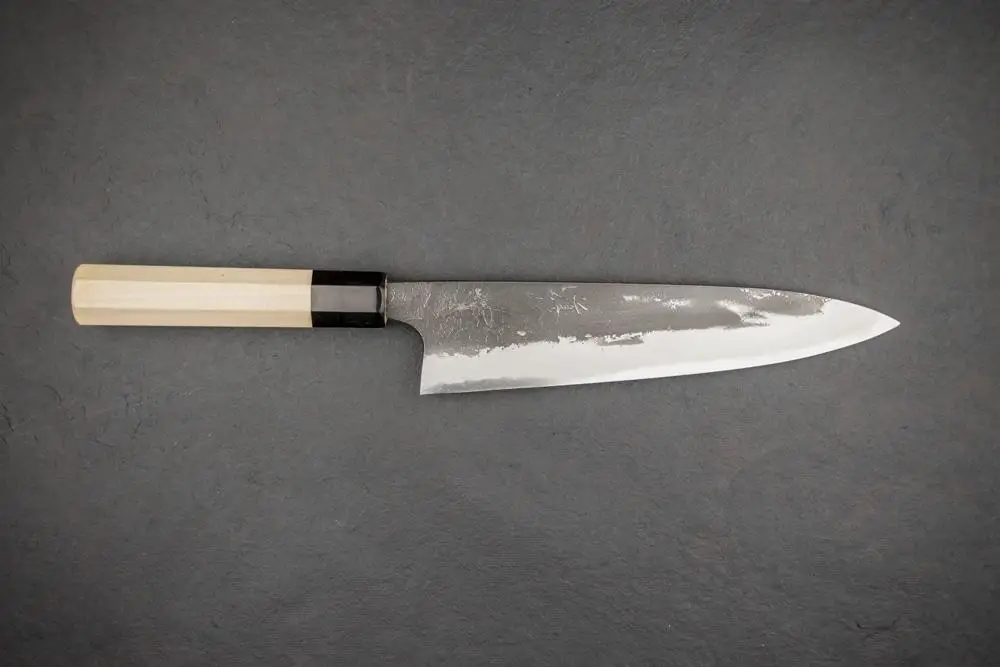
White steel is another high-end carbon steel used in Japanese kitchen knives. It is also made by Hitachi, and comes in multiple grades — #1, #2, and #3. White Steel #1 has the highest carbon content, while #3 has the lowest. Everything else is exactly the same. This means that of the three grades, #1 will have the best hardness/edge retention, while #3 will have the best toughness. White Steel #2 is probably the most commonly found grade used, while #3 is the least used.
Compared to Blue Steel or Super Blue Steel, White Steel does not contain any Chromium (CR), Tungsten (W), or Vanadium ((V)). Everything else is pretty much identical. This means that White Steel has slightly worse edge retention and corrosion resistance, but has a bit better toughness and is easier to sharpen. There’s always a trade off!
Similar to Blue Steel, White Steel is also very pure (i.e. low levels of P and S). It is most often used in higher end traditional Japanese knife types. The main benefit over Blue Steel is that it is easier to sharpen, which may makes it the preferred choice by some professional chefs.
Example white steel #1 knife: Fujiwara Nashiji Gyuto 210mm
Example white steel #2 knife: Mazaki Shirogami Nashiji Gyuto 210mm
Example white steel #3 knife: Shigeki Tanaka Silver Steel No.3 Nashiji Santoku 165mm
Composition of White Steel #1 (Source)
| Element | C | Mn | Si | P | S | Hardness |
|---|---|---|---|---|---|---|
| % | 1.25-1.35 | 0.20-0.30 | 0.10-0.20 | ≦0.025 | ≦0.004 | HRC 60+ |
Composition of White Steel #2 (Source)
| Element | C | Mn | Si | P | S | Hardness |
|---|---|---|---|---|---|---|
| % | 1.05-1.15 | 0.20-0.30 | 0.10-0.20 | ≦0.025 | ≦0.004 | HRC 60+ |
Composition of White Steel #3 (Source)
| Element | C | Mn | Si | P | S | Hardness |
|---|---|---|---|---|---|---|
| % | 0.80-0.90 | 0.20-0.30 | 0.10-0.20 | ≦0.025 | ≦0.004 | HRC 60+ |
Interesting note — during the power grinding steps of manufacturing, the white and blue steels can be distinguished by their sparks. White steel produces many bright sparks, but blue steel produces fewer, smaller sparks.
Yellow Steel / Yellow Paper Steel (i.e. Kigami) – #2, #3
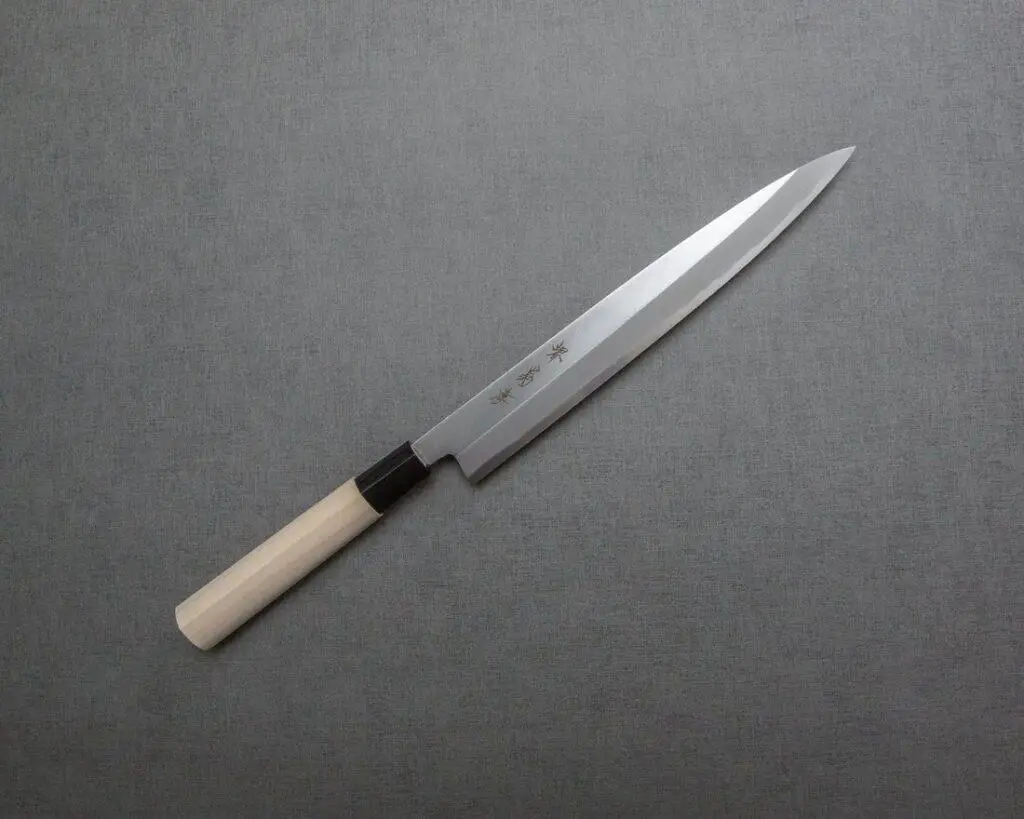
Yellow steel is an entry-level, high-carbon knife steel produced by Hitachi. It is found in two grades — Yellow #2, and Yellow #3. I don’t know why there is no #1. The #3 variation is also no longer listed in their official catalog, so it is possible that it is no longer being produced.
Yellow steel is basically a less pure version of its White Steel counterpart (i.e Yellow #2 = less pure White #2). This is due to higher amounts of both Phosphorus (P) and Sulfur (S) found in Yellow Steel. Other than that, the composition is identical.
I don’t see that many yellow steel knives on the market. Perhaps most people looking for a high carbon blade would prefer to go for the higher end white/blue steel, or for the even cheaper (and less pure) SK steel (see next steel type).
Example knife: Sakai Takayuki “Kairyo-Kasumitogi” Yanagiba
Composition of Yellow Steel #2 (Source)
| Element | C | Mn | Si | P | S | Hardness |
|---|---|---|---|---|---|---|
| % | 1.05-1.15 | 0.20-0.30 | 0.10-0.20 | ≦0.030 | ≦0.006 | HRC 60+ |
Composition of Yellow Steel #3 (Source)
| Element | C | Mn | Si | P | S | Hardness |
|---|---|---|---|---|---|---|
| % | 0.80-0.90 | 0.20-0.30 | 0.10-0.20 | ≦0.030 | ≦0.006 | HRC 60+ |
SK Steel (SK-3, SK-4, SK-5)
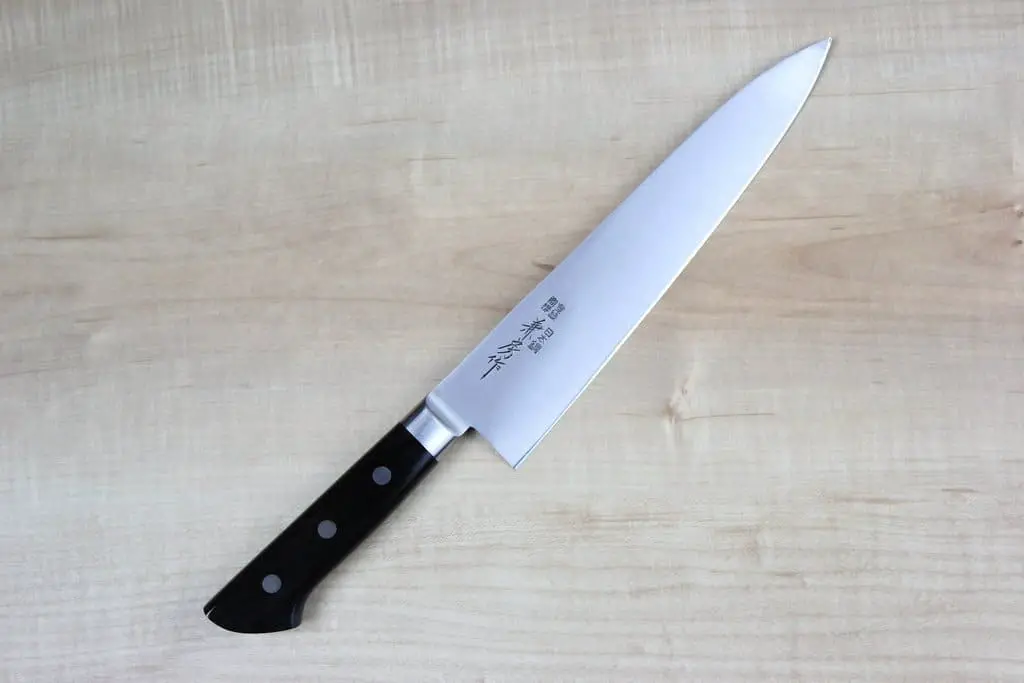
SK steel is the lowest end high-carbon steel type you will find used in Japanese knives. SK steel is not a brand like the above mentioned Hitachi steels, but a general steel grade/classification set by JIS
Similar to Blue/White/Yellow steel, SK steel also comes in variations. The most commonly used variations in Japanese kitchen knives are SK-3 (i.e. SK-105), SK-4 (i.e. SK-95), and SK-5 (i.e. SK-85). SK-3 has the highest carbon content, while SK-5 has the lowest. All other elements are the same (see composition charts below). SK steel contain a relatively high amount of impurities (i.e. P and S), so is considered as lower end steel compared to the Hitachi made steels listed above. They are easy to work with though, and are budget friendly, so are recommended for people looking to foray into high-carbon blades.
Many knife makers will relabel SK steel with their own brand name or just generically call it “high carbon steel”. If you find a cheap high-carbon steel Japanese knife that does not explicitly list the name of the steel, then it is probably SK steel. The new classification names for SK-3, SK-4 and SK-5 are SK-105, SK-95, and SK-85 respectively.
Example knife (SK-4):
Composition of SK-3 / SK-105 (Source)
| Element | C | Cr | Ni | Mn | Si | P | S | Cu | Hardness |
|---|---|---|---|---|---|---|---|---|---|
| % | 1.05-1.15 | 0.00 – 0.30 | 0.00 – 0.25 | 0.20-0.30 | 0.10-0.20 | ≦0.030 | ≦0.006 | 0.00 – 0.25 | HRC 60+ |
Composition of SK-4 / SK-95 (Source)
| Element | C | Cr | Ni | Mn | Si | P | S | Cu | Hardness |
|---|---|---|---|---|---|---|---|---|---|
| % | 0.90-1.00 | 0.00 – 0.30 | 0.00 – 0.25 | 0.20-0.30 | 0.10-0.20 | ≦0.030 | ≦0.006 | 0.00 – 0.25 | HRC 60+ |
Composition of SK-5 / SK-85 (Source)
| Element | C | Cr | Ni | Mn | Si | P | S | Cu | Hardness |
|---|---|---|---|---|---|---|---|---|---|
| % | 0.80-0.90 | 0.00 – 0.30 | 0.00 – 0.25 | 0.20-0.30 | 0.10-0.20 | ≦0.030 | ≦0.006 | 0.00 – 0.25 | HRC 59+ |
Bonus Japanese Steel Type: Tamahagane 玉鋼 (i.e. samurai sword steel)
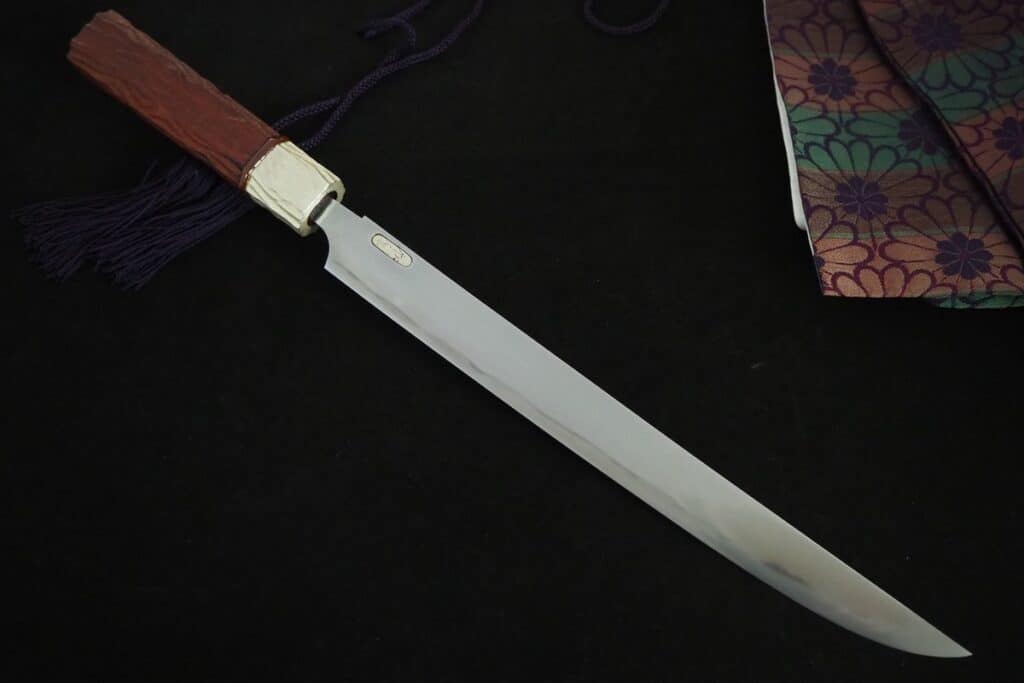
Tamahagane (玉鋼) is a traditional Japanese steel made from iron sand, and produced in a special clay furnace called a “
The unique use of iron sand (instead of the typical iron ore which is rare in Japan) and tatara furnace, results in tamahgane being an extremely pure steel. In fact, it is much purer than most modern steels. Tamahagane also achieves the ultimate balance between the properties of toughness, strength, hardness, and wear/corrosion resistance. It is often said that swords made with tamahagane, “do not break, do not bend, and cut well” 「折れず、曲がらず、よく切れる」. There are actually three grades of tamahagane. The first grade was traditionally used for swords. It is the purest and has the highest level of carbon (1.0-1.5%). The third grade is the least pure and has the lowest carbon content (0.3 – 1.0%), and was used for cheaper steel products.
The production of tamahagane is very inefficient, and time/labour intensive. It takes 36-72 hours to produce a batch. The yield of tamahagane produced from raw iron sand is also extremely low. This, along with the lack of need of samurai swords, resulted in tamahagane production losing favor to more modern, cheaply/easily/efficiently produced steels over time. Luckily for us, after realizing that the unqiue methods used to create tamahagane would be forgotten, efforts were made by various organizations and the Japanese government to preserve its production technique.
Thanks to these preservation efforts, tamahagane steel is still being produced today, though in very limited quantities. The ‘Nittoho Furnace‘, located in Shimane, Japan, is one of the few remaining traditional tatara furnaces in the country, and is managed by major steel manufacturer Hitachi. It only operates in winter (for lowest humidity), and sells only to master swordsmiths in Japan.
As you may expect, Tamahagane knives are extremely expensive!
Example knives:
Yasha Yukawa Tamahagane Warikomi Ryoba Deba ($1750 USD)
Example Composition of Tamahagane 1st grade (Source )
| Element | C | Mn | Si | P | S | Cu | Hardness |
|---|---|---|---|---|---|---|---|
| % | 1.36 | 0.01 | 0.03 | 0.029 | 0.0026 | 0.01 | HRC 60+ |
Conclusion / Summary
That’s it! My ultimate guide to the best Japanese knife steel types!!
Like most things in life, the “best” Japanese knife steel type depends on your own unique needs and circumstances. If you are a beginner and/or on a tight budget, you probably want to opt for a knife made with cheaper stainless steel like Molybdenum Vanadium, AUS-8/10, or VG-10. If you are experienced and have some cash to spend, but don’t want to be bothered with maintaining a high-carbon blade, then you may opt for higher end stainless steel like Gin-3, or SG-2.
For those looking to experiment with their first high-carbon blade, it would be wise to start with a cheaper variation like SK steel or Yellow steel. Once you have experience working with and maintaining high-carbon blades, you will probably want to move up to a White or Blue Steel for better cutting performance.
There are also many Japanese knives these days that use a high-carbon core, with stainless steel cladding, so you can try to get the best of both worlds!
I hope that this information can help you make a better informed decision when purchasing your Japanese kitchen knife. I personally learned a lot while researching/writing this article. If I missed anything important, or made any mistakes, please feel free to leave a comment or contact me.
What is your preferred steel type? What steel does your current knife use? Let me know in the comments!
Summary Chart
* indicates PM steel
| Stainless Steels | HRC | Price Range ($ – $$$) |
|---|---|---|
| Cowry-X* | 63+ | $$$ |
| ZDP189 / MC66* | 65+ | $$$ |
| SG-2 / SPG-2 / R-2* | 61 – 64 | $$ to $$$ |
| Silver-3 (Gin-3) | 59+ | $$ to $$$ |
| VG-10 | 60+ | $ to $$ |
| VG-1 | 60+ | $ to $$ |
| Swedish Steel: AEB-H / 19c27 | 55 – 63 | $ to $$ |
| Swedish Steel: AEB-L / 13c26 | 55 – 62 | $ to $$ |
| ACUTO440 | 58-59 | $ to $$ |
| AUS-8 / AUS-10 | 59-60 | $ to $$ |
| Molybdenum Vanadium Steel (i.e. MV Steel) | 56+ | $ |
| High Carbon Steels | ||
| HAP-40* | 64-68 | $$$ |
| Super Blue Steel (Super Aogami) | 60+ | $$$ |
| Blue Steel (Aogami) #1, #2 | 60+ | $$ to $$$ |
| White Steel (Shirogami) #1, #2, #3 | 60+ | $$ to $$$ |
| Yellow Steel (Kigami) #2, #3 | 60+ | $ to $$ |
| SK Steel (SK-3, SK-4, SK-5) | 59+ | $ |
| Other: Tamahagane | ??? | $$$+ |
Sources
https://www.hitachi-metals.co.jp/ https://zknives.com https://www.kai-group.com/products/special/hocho/learn/material/ https://story.nakagawa-masashichi.jp/39138 https://japanesechefsknife.com/ https://hidatool.com/tools/aogami-shirogami/ https://www.polymersolutions.com/blog/defining-metal-properties/ https://sharpedgeshop.com/blogs/knives-101/steel-heart-of-japanese-knives https://www.knivesfromjapan.co.uk/materials-guide-i22 https://www.japanny.com/pages/japanese-knife-blade-steels https://japanahome.com/journal/steel-qualities-kitchen-knives-cheat-sheet-chart https://takahashikusu.co.jp/en/ https://kazsknifeonline.com.au/blogs/knife-knowledge-and-information-1/what-is-the-difference-of-knife-by-steel https://en.wikipedia.org/wiki/Steel https://www.differencebetween.com/difference-between-carbon-steel-and-vs-stainless-steel/ https://www.jikko.jp/houchou/hagane.html
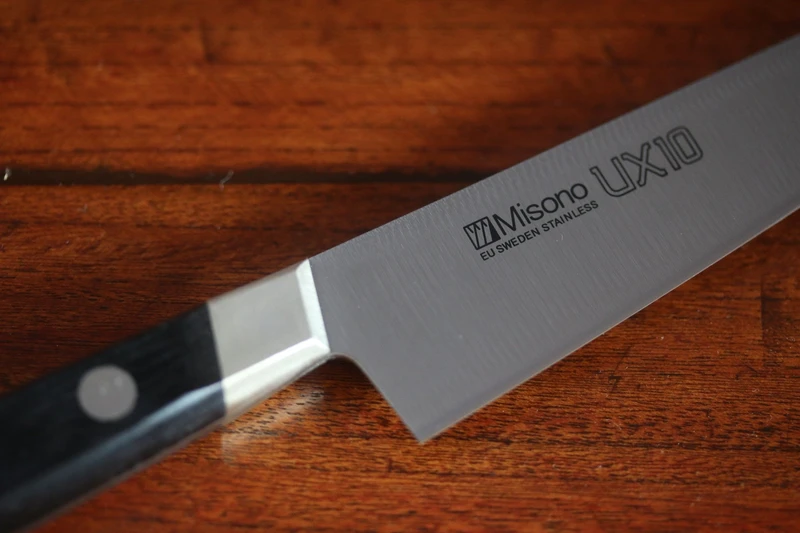
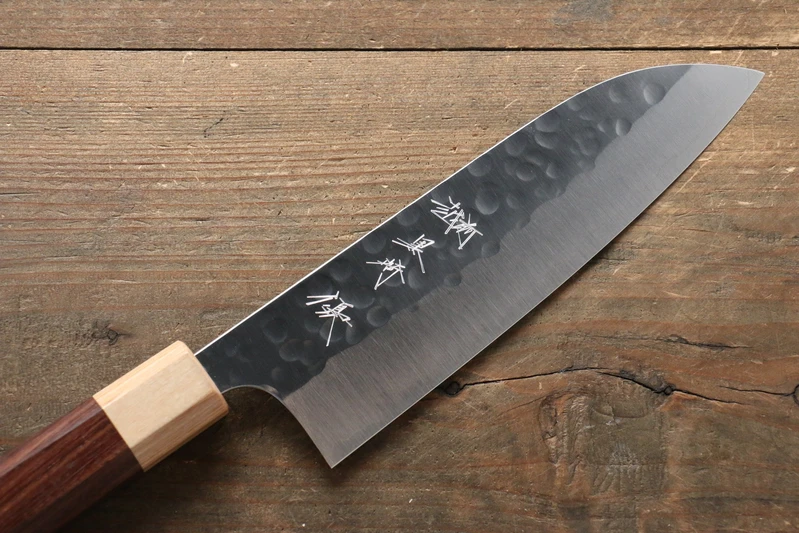
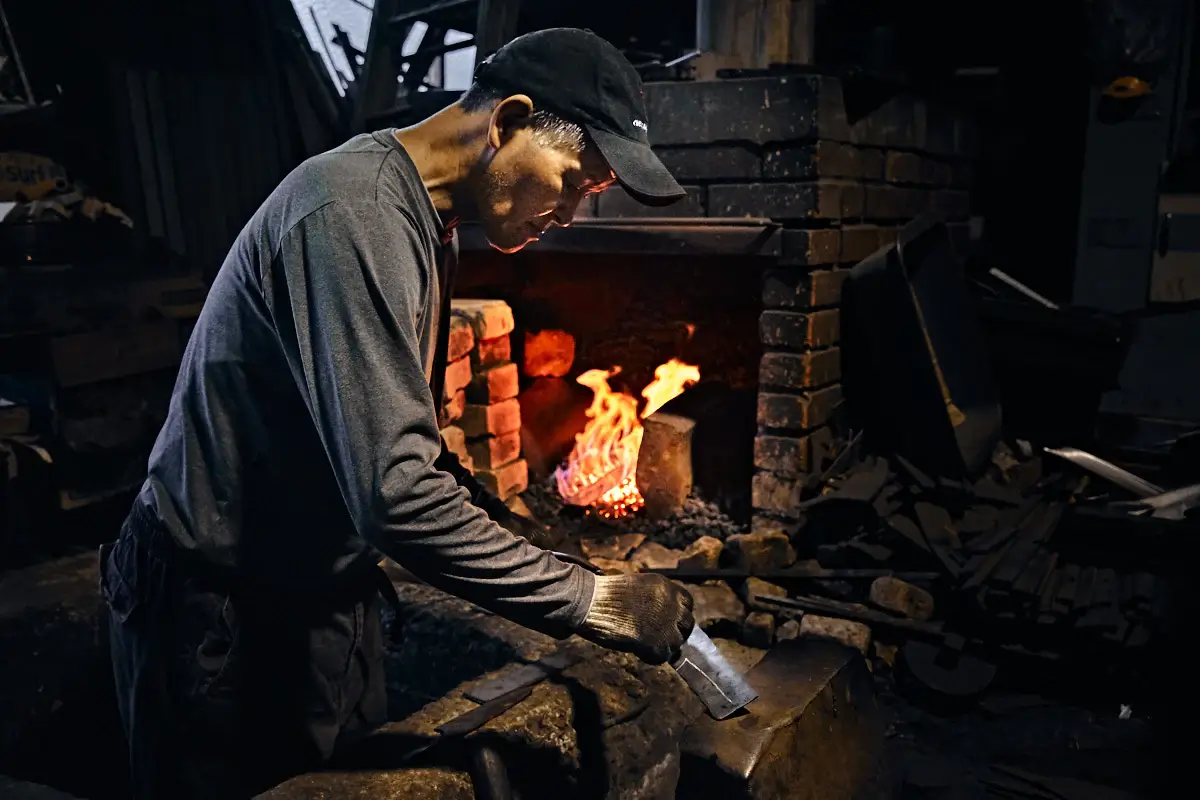
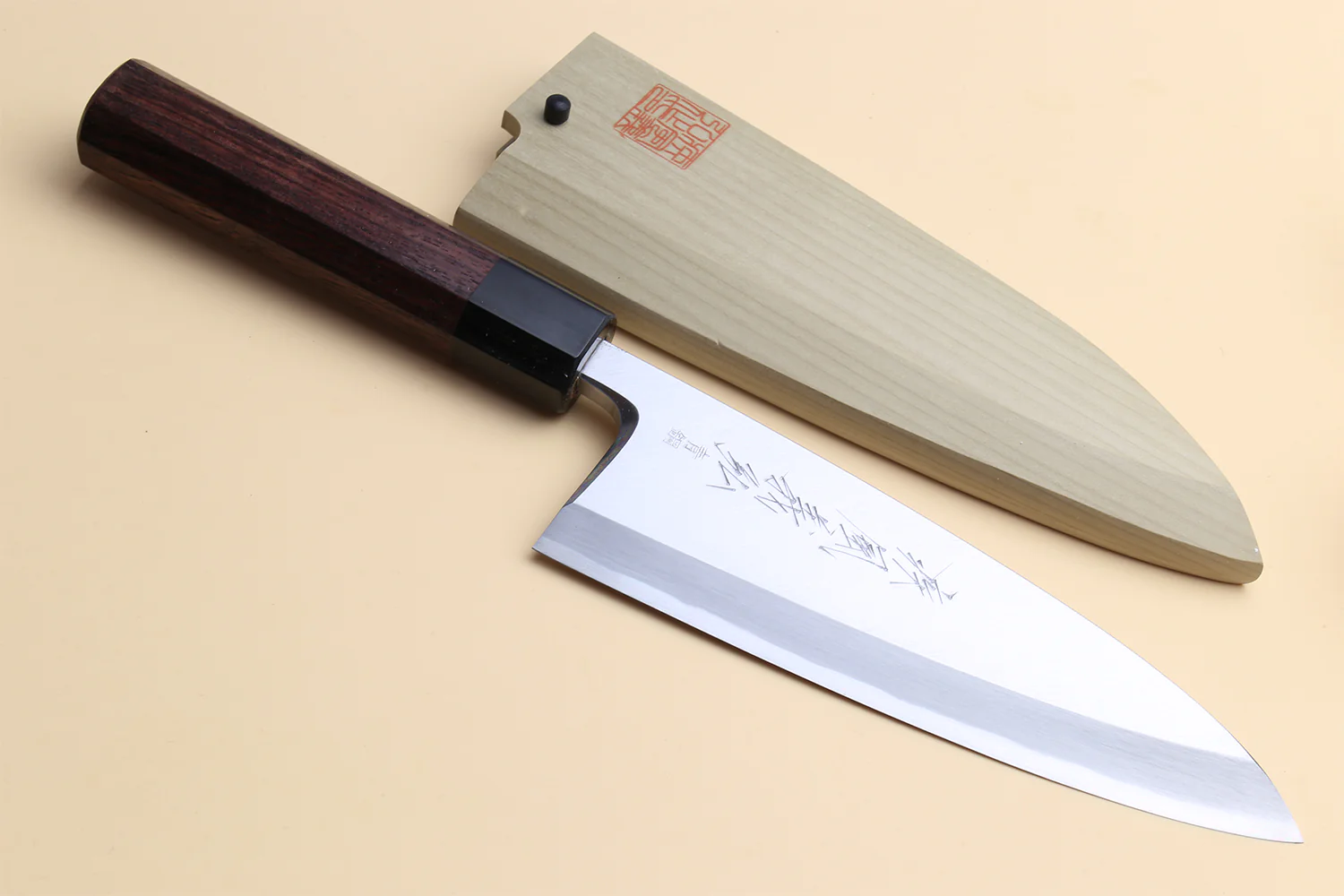
Hi,
Thank you for such a detailed blog on chef knives. My son (college age) loves to cook and I want to get him 3-4 knives that chef’s use most often. I want great quality that will last him for years to come. I also would like your opinion on a high quality knife leather roll or advice on the best way to store the knives I buy him for christmas. Thanks in advance.
Lisa